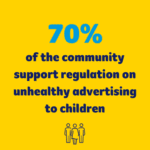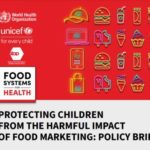Category: Regulation

On average, Australian school-aged children eat more than one-third of their daily energy intake during school hours. What’s in the school lunch box is therefore important. However, over 40% of energy consumed during school hours is from “discretionary” foods and drinks, which according to the Australian Dietary Guidelines, should only be consumed sometimes and in […]

Independent MP Dr Sophie Scamps has introduced a Private Members Bill into federal parliament to ban unhealthy food marketing on TV, radio and online. How will this Bill work? The Healthy Kids’ Advertising Bill 2023 aims to protect children from unhealthy food marketing by amending the Broadcasting Services Act 1992 to remove ads on TV and […]

Junk food advertisements surround our kids; during prime-time TV, popping up online, travelling with them on buses and trains. The advertisements send harmful messages to kids about healthy eating. Changes to the AANA food and beverage code in 2021 are merely window dressing and will go no way to protect children from exposure to junk […]

The recent complaint by a parent about a brightly coloured ad for a sugary drink on the side of a school bus has shown how poorly the advertising industry codes protect children. The advertisement The ad for a bright red and green Hungry Jacks slushie was on the side of a school bus outside a […]

Government action on policies to deal with food marketing is more likely if the community is also behind it. Cancer Council has been asking the NSW community about their support for certain government actions every three years since 2013. The findings Our 2022 survey found that 70% of the community want children protected from unhealthy […]

After a much-anticipated wait, the NSW Government has released the Healthy Eating and Active Living (HEAL) Strategy 2022-32. Food marketing policy fail At first glance, the strategy seems comprehensive, including prevention programs, advice as part of clinical care, social marketing campaigns and addressing the food and built environment. However, the actions to address the food […]

Cancer Council NSW is asking the NSW government to take a responsible approach to advertising on state property – such as public transport – by removing advertisements for unhealthy food and drinks. Around Australia, other state Cancer Councils are advocating for their governments to do the same. Around the country The ACT government led […]

A complaint to the Ad Standards has shown that despite updates to the AANA Food and Beverage Code, loopholes within the Code allow ads for unhealthy food to be shown during prime-time TV shows. This demonstrates that the changes in the code have made no difference in protecting children from exposure to unhealthy food advertising. […]

Positive changes to the rules on what can be advertised on Transport for London (TfL) services have resulted in weekly household purchases of unhealthy foods dropping by 1,000 kcal. Introduction of restrictions In February 2019, restrictions on the outdoor advertising of unhealthy foods and drinks across the TfL network were implemented. This included the London […]

The World Health Organization and the United Nations Children’s Fund have released a policy brief on options to increase the protection of children from the impact of food marketing. This brief adds to the already large number of publications produced by WHO that build on the evidence base. What should policy look like? The brief […]
